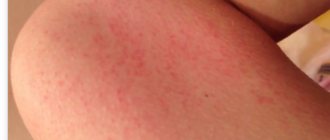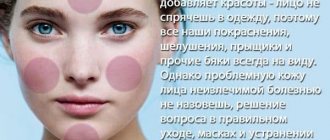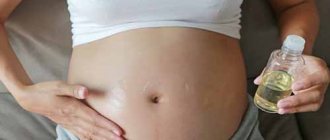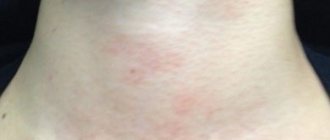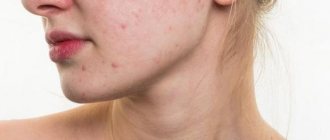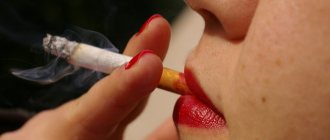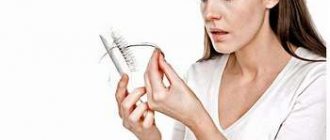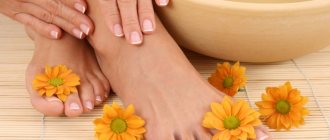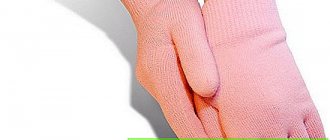Who has burning and itchy spots on their body?
People with increased nervous excitability are at greater risk of developing red spots. The itching of such spots is explained precisely by a nervous disorder.
A number of procedures will help get rid of this phenomenon: sports, proper rest, contrast shower. Such measures will help to significantly reduce the affected area and prevent the appearance of stains in the future.
Redness can also be caused by an insect bite. In this case, if there are no serious symptoms, there is no cause for concern.
Main types of stains
In terms of external characteristics, brown areas vary greatly. The classification of different rashes is briefly described below.
| View | Description |
| Lentigo | Flat spots on the skin of brown color. The shape of the rash can be round or elongated. They can be single or numerous. |
| Freckles | Small rashes. The formations can completely disappear in winter. |
| Chloasma | Characterized by hyperpigmentation. New growths are light brown. Usually such rashes are localized near the face. |
| Nevi | In simple words, these are birthmarks. They have smooth outlines. Light brown spots on the body can degenerate and take on a malignant form. Symptoms such as an increase in size and change in the shape of a mole are dangerous. |
You will not be able to recognize on your own what kind of tumor is present and how to get rid of it.
The red spot on the leg is burning
The appearance of red spots on the legs is due to many processes occurring in the human body. This is a kind of body signal that seeks to warn of danger. Such warnings should never be ignored, and at the first symptoms of various redness, you should seek specialized help. Itching and burning of such spots indicates that the disease is in the progression stage and is developing.
Even if the area of redness does not bother a person in any way, you should see a doctor immediately, as a benign tumor may develop. It is easy to treat in the initial stages of its development, so you should never ignore any changes in your body, so that later it is not too late.
Also, a serious reason for the appearance of spots on the legs can be an increased level of glucose in a person’s blood. Quite often, diabetes mellitus becomes a serious causative agent of dangerous inflammatory processes. The knees and feet are places with a special tissue structure. It is in these areas that malnutrition usually occurs, leading to changes in skin color.
Redness on the legs of children can be caused by allergic and infectious reactions, and blood diseases.
An unpleasant cause of this disease can be a fungus. The sore spot most often becomes covered with cracks, itches and burns.
Dark spots
Dark pigmentation is disorders such as melasma or melanosis, blue-gray dispigmentation.
Melanosis is promoted by any long-term and severe chronic disease. This causes the deposition of melanin in the skin. Common pathologies are:
- Endocrine melanosis, which occurs with insufficiency of the adrenal cortex, dysfunction of the gonads, diabetes mellitus, thyrotoxicosis, etc.
- Hepatic melanosis, developing against the background of impaired liver function.
- Cachectic melanosis in tuberculosis.
- Uremic - occurs in chronic renal failure.
Becker's melanosis
Or it is also called Becker's nevus. Often occurs in boys aged 10 to 15 years. Men and women are rarely affected by them.
A nevus looks like a yellow or dark brown spot of irregular shape with growing hair. Most often it appears on the shoulders, forearms, chest, and back. Can grow up to a diameter of 20 cm.
The reasons for the appearance of nevus are still not clear. There are suggestions that this may be due to a hereditary predisposition to this type of pigmentation or the body’s reaction to ultraviolet radiation.
Dubreuil's melanosis
It appears as a flat, dark-colored spot, possibly slightly raised above the skin. The size on average reaches 5 cm, but after a few years it grows to 10 cm.
The color varies from light brown to dark and sometimes black. This melanosis is considered a precancerous condition. Often accompanied by papillomas and nodular elements.
The damaged areas are dense, with peeling and erosion. The skin around such a formation reacts with the appearance of redness, freckles, and foci of keratosis, which are indicators of the degeneration of melanosis into melanoma (a malignant tumor).
The causes of Dubreuil's melanosis are:
- age;
- abuse of ultraviolet radiation;
- skin sensitivity to light;
- skin injury;
- overdrying of the skin.
Urticaria pigmentosa
A common disease in children. Hives look like red-pink spots that develop into blisters with liquid. The spots are very itchy.
And after opening the blisters, brown-brown marks remain on the skin. Urticaria occurs more often in children. As a rule, the spots disappear during puberty.
If an adult falls ill with urticaria, the situation is complicated by the appearance of systemic mastocytosis, which often leads to disability or death.
The causes of urticaria pigmentosa are still being studied. Presumably, provoking factors are:
- immune system response;
- stress;
- climate change;
- inflammation and infections;
- genetic predisposition.
Coffee-colored spots - Nevus Spilus
This hyperpigmentation occurs in the form of single spots with an even color and clear boundaries on any area of the skin. Pigmentation can appear from birth.
The spots are never hairy and have dark or black dots on the surface. Presumably the reason for the formation is heredity.
Freckles
These are small dark spots on the face or body. Pigmentation becomes more noticeable in the warm season with solar activity. Freckles may disappear as you age.
It is more common in people with light hair, eyes, and skin. Scientists have proven the dependence of the appearance of freckles on hereditary predisposition.
Recklinghausen's disease
The spots look like clusters of freckles, appear in unusual places and take on a café-au-lait hue.
Such formations can appear from birth or in childhood. The color varies, but brown shades predominate.
Rarely does the spot acquire a gray-blue color. Formations appear on the surface of the arms, legs or torso in an amount of at least 5 pieces. The patient is affected by nerofibroma, which subsequently spreads to other organs - nervous tissue, adrenal glands, etc.
Such spots degenerate into cancer from 3 to 15% of cases. The nervous system and musculoskeletal system suffer. Epilepsy, depression, fatigue occurs, vertebrae are destroyed, cysts appear, etc.
The mutating gene of chromosome 17, which is inherited, is to blame for the appearance of this disease.
Nevus Ota and Ito
Ota manifests itself as a single spot of black-bluish or dark blue color in the eye area, upper jaw or cheek. Sometimes you can find merging spots. Even less commonly, pigmentation can be bilateral.
The disease sometimes spreads to the sclera and nasopharyngeal mucosa. The spots appear from birth and do not go away on their own.
Scientists have not yet determined the cause of nevus of Ota. Often this disease affects people of the Mongoloid race and very rarely Europeans and the Negroid race.
Nevus of Ito is similar to nevus of Ota. The only difference is in its location - neck, chest and shoulder blades.
The red spot on the hand is burning
Redness in the palms appears due to hormonal imbalances caused by pregnancy or adolescence. Skin mites could also cause red spots on the palms. At night, the pain may intensify. Peeling and itching of red spots in the elbow area is an allergy to some food product or household chemicals. In this case, it is worth carefully reconsidering your diet or the products that a person uses to care for the body.
Another reason for redness on the hands is lichen. It can cause severe itching, burning and pain. Treatment is prescribed only by a doctor, based on the symptoms.
After being outside for a long time during cold weather, some people may develop red spots on their hands that burn and bake unpleasantly. In order to avoid such a problem in the future, you should use protective and moisturizing creams and always wear gloves. If this problem does not disappear, consult a dermatologist.
Treatment
Treatment in most cases is complex . It involves the prescription of medications internally and externally, traditional medicine, and physiotherapeutic techniques.
Diagnostics
First, a diagnosis is made by a dermatologist. The doctor listens to complaints and conducts an examination. The dermatoscopy method allows you to clarify the condition of the tissues. Scraping and bacteriological culture are also performed, and a blood test is prescribed.
Treatment options
Many diseases require drug treatment. If the cause is an infection, antibacterial or antiviral drugs are prescribed. For allergic diseases, desensitizing agents will be required - suprastin, diphenhydramine, corticosteroids. Vascular permeability is reduced by ascorbic acid and rutin. Patients can be registered at a dispensary.
Physiotherapy shows good results. For example, infrared radiation accelerates tissue regeneration, increases resistance to microbes, and eliminates inflammation.
Laser radiation is effective in cases of hyperpigmentation and allergic rashes.
For a number of diseases, chemical peeling and laser therapy are prescribed.
If the process has become malignant, specific treatment methods will be required - chemotherapy, radiation, etc.
Important! Self-medication is dangerous because it can cause the condition to worsen.
Folk remedies
In folk medicine there are many recipes that will help cope with some skin imperfections.
- From freckles. A mask made from a bunch of parsley and a tablespoon of honey will cleanse your face. To do this, chop the parsley, add honey, and grind the ingredients to a mushy state. Apply the product for 40 minutes and wash.
- From bruises. Apply a softened cabbage leaf to the hematoma.
- For allergies. They make lotions from the infusion of the string - 150 g of herb and 500 ml of boiling water. Leave for 60 minutes.
- From ringworm and red lichen. An ointment is prepared from hop cones, burdock root (20 g each) and calendula (10 g). The herbs are poured with water (200 ml) and left for an hour. Then two parts of Vaseline are mixed with one part of the decoction, and compresses are made twice a day.
Drugs
The choice of drug for external use depends on the cause of the lesion. The following drugs are used:
- Clotrimazole ointment, sulfuric, salicylic ointments - effective against fungi, lichen;
- Fukortsin, brilliant green - for chickenpox;
- Fluocinolone - against psoriasis.
When should you see a doctor?
A dermatologist treats skin diseases. If necessary, an allergist, infectious disease specialist, venereologist, and immunologist are involved.
You should immediately seek medical help if the temperature rises, swelling occurs, especially extensive, nausea, vomiting occur , especially in children of primary school age.
The appearance of dark spots on the skin, especially if at first the size is small, the silhouette is round, and then the formation grows and changes shape, should also be a reason to consult a doctor. This is especially important if symptoms such as rough skin, bleeding, color change, or skin itching appear. The doctor will find out why changes and flaky surfaces appear, determine how to treat, and tell you the name of the necessary medications.
What to do if red spots on the body itch and burn
Starting to treat reddened areas on your own is a bad idea. The use of many drugs can only worsen the situation. It is also necessary, as far as possible, not to scratch the inflamed area and refrain from sun exposure to this area.
You can try to soothe the affected area of skin with various herbal decoctions. Chamomile and string can effectively help in this matter. It will be enough to prepare compresses and lotions.
Ice cubes with a decoction of calendula or green tea are good for relieving itching and pain. But it is worth remembering that these measures are aimed only at alleviating the symptoms that have arisen, but not at completely eliminating them. For an accurate recovery, you need to seek specialized help.
Other spots
If unusual formations appear on the skin, a person should first seek advice from a dermatologist.
Only a specialist can determine the disease by appearance, size, color, shape and other indicators and prescribe appropriate treatment.
If the case requires confirmation of the diagnosis, you will need to take scrapings from the damaged area and consult an oncologist or venereologist.
Depending on the problem, different treatments may be prescribed:
- the primary disease and the resulting spots are its symptoms;
- allergen, if allergy appears with supportive therapy;
- lichen spots, which require an integrated approach with the use of oral and external remedies, the use of hygiene products and strengthening the immune system;
- pigmented areas lightened with special means, peelings, mesotherapy, cryo procedures, laser.
